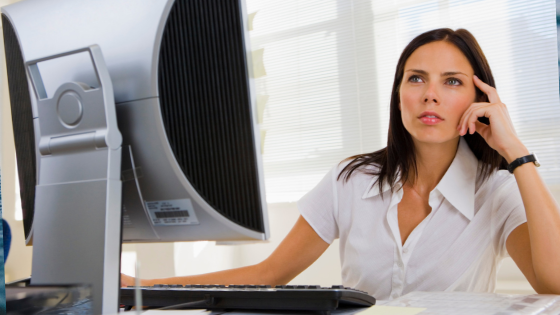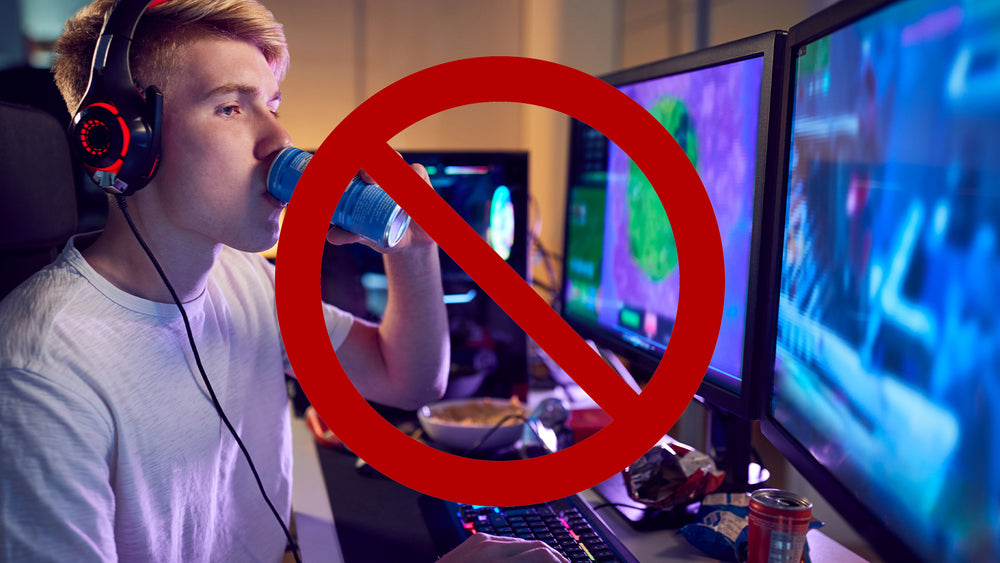Few people can escape working at a computer for a significant portion of their day. Between writing reports, entering orders and sending emails, you probably see more of a computer screen than your co-workers.
You may not be able to cut down on your computer time, but you can make it easier on your eyes, back and shoulders by following some basic rules.
You need to get up and walk around every ten to twenty minutes stand when you can, sit on a exercise ball, do “deskercise”, or use an under desk ellipticals. Movement, even stretching once in a while, is the key to improve health if you have a sedentary job.
If you are in a traditional office it may be hard to do this, but at home or in a casual office, it should be easy to apply all the proper work habits. It may take awhile before you are successfully incorporate all these healthy habits, but you’ll feel much better, and become more productive, when you do.

Protect Your Eyesight
Don’t accept the position of your computer screen, the size, or the settings as permanent. If the screen is too close or too far away for you to see it properly, rearrange your desk, or have your office manager or computer tech recommend the best way to reposition it.
Change the view settings on your computer so the font will be larger as you work. (If you need to print out a report, be sure to change the font to an appropriate size for the printed page.) You can also change the brightness and contrast on your monitor.
If you work too long at your computer without taking a break, or use poor work habits, it may result in computer vision syndrome.
Avoid computer vision syndrome by following these tips:
- Your computer should be four or five inches below eye level and 20 to 29 inches away from your eyes. Most people are more comfortable looking downward at their computer.
- If you are typing from a document, it should be placed below the monitor and above the keyboard. You can also use a document holder to the side of the monitor. Position the document in such a way that you don’t need to move your head from the document to the screen.
- Use a screen glare filter if you can’t place the monitor in a position to avoid glare from sunlight or overhead lights. Use drapes and blinds to minimize glare and use lower wattage light bulbs in desk lamps.
- Blink frequently when using your computer. It will prevent dry eyes.
- Sit in a padded chair, and make sure your feet are flat on the floor. The arms on your chair should support your arms as you type. Don’t rest your wrists on the keyboard as you work.
- Rest your eyes every 15 minutes after using the computer for two straight hours. Look 20 feet into the distance for 20 seconds after 20 minutes of computer use to refocus your eyes.
- Also, make sure you visit your optometrist every few years. Adults 65 and over should visit their optometrist every year or two.
Using Your Mouse
Choose a mouse that fits your hand and moves freely. Keep your wrist neutral and straight and use your elbow as the pivot point. According to OSHA, typing without a wrist rest may make your wrists bend to an uncomfortable angle. This will increase contact stress and the irritation on tendons.
Your hands should be elevated above the wrist rest as you type. However, if you rest your wrists on a support when you’re typing, it might inhibit wrist motion. Reduce your wrist bending by changing your workstation so the wrist remains in a neutral position.
You should ensure that the front edge, height and width of your keyboard match the wrist support. Remember, you want to keep the wrist supports straight. The palm and wrist supports should be round and soft to reduce pressure on the wrist. The support needs to be at least 3.8 cm. or 1.5 inches deep.
Your keyboard should be located so your elbows and upper arms are close to your body. Your arms should not extend more than 45 degrees outward. There should be weight-bearing support, such as a wrist rest or chair arms, when you use the keyboard.
Your wrist (and the position of your mouse) should be aligned straight with your forearm not bent. Your arms and wrists should rest on surfaces without any sharp edges.
Walk and Be More Physically Active During the Workday
Studies show that sitting all day increases your chance of injury and affects your circulation, heart and may lead to dementia. Doctors recommend that you sit no more than two or three hours a day, but for most of us, that’s not possible.
Administrative assistants, software developers, bus drivers and accountants spend most of their days sitting. Standing or using a treadmill desk can only increase movement so much for most people working desk jobs.
Using a treadmill or desk cycle is impractical for more than a few minutes at a time. What can you do to protect your heart and health if you’re tied to a desk all day?
If you’re on a deadline, or absorbed in your work, you might not notice that you’ve been sitting in a chair staring at a screen for five hours. Get up and move around every 20 minutes if you can, or every hour. Don’t let a few hours go by without getting up and stretching or walking for at least a minute or two.
Change your body position while working at your desk. Use a height adjustable chair, and/or one with coasters. These features allow you to move around, even though you may not be able to leave your workspace.
Schedule time for a walk or a trip to the gym. Walk to the park or a nearby restaurant for lunch. Don’t eat at your desk.
If you’re unable to leave your office for lunch or extended breaks, get up a half-hour earlier and exercise at home or take a walk around your block. If you live close to your job, walk or bike to work. You can get up early and go to the health club. You’ll get endorphins flowing and be a lot happier when you get to work!
Stand and/or walk during meetings or discussions, if possible. Use headphones during phone meetings and take a walk. Keep moving however you can without sacrificing the quality of your work.
Use a stability ball instead of a chair if you’re unable to get away from your desk. You’ll need to engage your midsection (core) muscles to sit straight. A stability ball will help you strengthen your abdominal muscles and improve your posture.
Vary your routine. Leave for work early and grab a cup of coffee in that new diner in your neighborhood, or run an errand that’s a little out-of-the-way (but not far enough to make you late).
Instead of dawdling in your chair at work before your official start time, you’ll discover a new restaurant or get a boring but necessary task done.
Plan your breaks and lunches, just like you plan the rest of your day. Take a walk outside on your morning break and buy health or beauty aids from the drugstore near your office, or use a restroom on the other side of the office. Do anything that will help you take at least a few extra steps during your workday.

Sitting in and Adjusting Your Chair
Push your hips as far back in the chair as you can, and adjust the height so your feet are flat on the floor. Your knees should be equal to, or a bit lower, than your hips.
The back of your chair should be at a reclined angle of between 100 and 110 degrees. Use small pillows or a cushion to support your lower back.
Use the mechanism on the back of your chair to change the position as needed. Adjust the armrests so your shoulders are straight and relaxed.
Most people who sit in an office chair all day slouch over closer to the screen or slouch down in the chair. Both positions can cause back and shoulder problems. They can also stretch ligaments and strain discs and structures in the spine. The wrong posture may cause long-term back pain or damage your spine.
Determine the height of the workstation or desk before you set up the office chair. Your height and the type of work you do will determine the position of the chair and workstation.
Make sure you can slide your fingers under your thighs at the edge of the office chair. If you can’t fit your fingers under your thighs, use an adjustable foot rest to prop up your feet. Tall people may need to raise the work surface or desk in order to raise the chair height.
Plan Your Work Day
If you’re self-employed or work a remote job, planning your work is probably pretty easy, since you won’t have bosses or co-workers interrupting your space. Anyone who works onsite in a traditional office may have a harder time sticking to a schedule, but it can be done.
Get to work a little early, and ask your supervisor if there are any pressing matters for the day. Arrange your schedule in advance. This will also help you schedule breaks more easily.
A salesperson or customer service rep won’t get to schedule their day like many other employees. Your day unfolds depending on the number of calls you take or the number of customers that contact you.
Arrange to take a certain number of calls before you take a break from the computer. If you find yourself working beyond the break time you’ve established for yourself, ask a co-worker to take over for you for a few minutes while you stretch or walk to the water cooler.
Planning your day will help prevent you from spending too long at the computer without a break. It’s easy to forget to take breaks when you are in the middle of a project or heading toward a deadline.
Although you may need to change your workday schedule as new problems arise, having a plan will make it easier for you to rest your eyes and avoid sitting for too long without a break.

Make a Healthy Diet and Proper Nutrition Part of Your Work Day
It’s important to eat healthy lunches and snacks during your workday. Fatty, greasy or sugary foods will pack on the pounds, and make you feel sluggish, especially in the afternoon.
In a study published in the British Journal of Nutrition, two groups of overweight adults were assigned to eat lunches with white bread or other refined carbohydrates, or lunches containing almonds. Both groups experienced lower memory test scores after eating, but the participants that ate almonds had higher scores than the refined carb group.
Eat snacks and lunches with unsalted nuts, fruits, veggies and lean protein to feel more energetic after lunch or any time.
If you have time to fix your lunch the night before, prepare Shopped Quinoa Salad with Cranberries, Cauliflower Crust Pizza, or Lentil Veggie Soup. You’ll save money, calories and get more nutrients than in a restaurant meal.
Avoid drinking soda or alcohol. Drink water, herbal tea, or decaffeinated coffee instead. Bring your own snacks from home or choose nuts or raisins from the vending machine instead of candy.
If you get bored or are between projects, take a short walk or do some busy work instead of heading to the snack shop or Starbucks.
Take a wheatgrass supplement to increase your energy and guard against health problems caused by work stress. REVV Natural Energy Supplement is made with pure wheatgrass.
Wheatgrass contains chlorophyll, the green pigment found in plants. Chlorophyll has been shown to have anti-aging and anti-cancer properties. It can also help heal wounds quickly and reduce body odor. Learn more about REVV here.
















